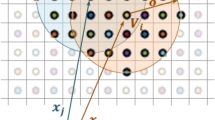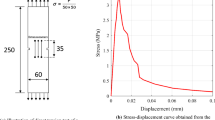Abstract
The objective of the present work is to propose an engineering-oriented numerical methodology capable of reproducing crack initiation and arrest in semi-brittle structures under high loading rate. With this aim in view, the SPH-based method implemented in LS-DYNA is employed to reproduce the three-dimensional crack initiation, propagation and arrest in a rate- and temperature-dependent grade of RT-PMMA under Kalthoff and Winkler-type impact loading. The ability of critical maximum principal stress- and critical plastic strain-controlled failure criteria, first individually and then combined to reproduce the crack arrest was evaluated by comparison with experimental results. In spite of the overall brittle nature of the PMMA matrix, it was shown that the most pertinent criterion for the material of interest is the one expressed in terms of critical plastic strain, as a consequence of the gain in ductility brought by the embedded rubber nanoparticles. In pratice, the real crack pattern can be reproduced only if the two criteria are used together. Following a design of experiment, an optimised set of values for the critical maximum principal stress and plastic failure strain were found. A good agreement in terms of crack advance (as a function of the impact velocity) and propagation angle is seen between the experimental and numerical results.




























Similar content being viewed by others
References
Arruda EM, Boyce MC, Jayachandran R (1995) Effects of strain rate, temperature and thermomechanical coupling on the finite strain deformation of glassy polymers. Mech Mater 19:193–212
Batra RC, Gummalla RR (2000) Effect of material and geometric parameters on deformations near the notch-tip of a dynamically loaded prenotched plate. Int J Fracture 101:99–140
Batra RC, Ravinsankar MVS (2000) Three-dimensional numerical simulation of the Kalthoff experiment. Int J Fracture 105:161–186
Batra RC, Lear MH (2004) Simulation of brittle and ductile fracture in an impact loaded prenotched plate. Int J Fracture 126:179–203
Bjerke T, Li Z, Lambros J (2002) Role of plasticity in heat generation during high rate deformation and fracture of polycarbonate. Int J Plast 18:549–567
Chou SC, Robertson KD, Rainey JH (1973) The effect of strain rate and heat developed during deformation on the stress-strain curve of plastics. Exp Mech. 13(10):422–32
Combescure A, Coret M, Elguedj T, Cazes F, Haboussa D (2012) Cohesive laws X-FEM association for simulation of damage fracture transition and tensile shear switch in dynamic crack propagation. Procedia IUTAM 3:274–291
Estevez R, Basu S (2008) On the importance of thermo-elastic cooling in the fracture of glassy polymers at high rates. Int J Solids Struct 45:3449–3465
Haboussa D, Elguedj T, Leblé B, Combescure A (2012) Simulation of the shear-tensile mode transition on dynamic crack propagations. Int J Fract 178:195–213
Kalthoff JF (1988) Shadow optical analysis of dynamic shear fracture. Opt Eng 27(10):835–840
Kalthoff JF and Winkler S (1987) Failure mode transition at high rates of shear loading. In: Chiem CY et al (eds) Impact loading and dynamic behavior of materials. Informationsgesellaschaft Verlag Bremen, pp 185–195
Kobayashi AS, Mall S (1979) Rapid crack propagation and arrest in polymers. Polymer Eng Sci 19–2:131–135
Lalande L, Plummer CJG, Manson JAE, Gérard P (2006) Microdeformation mechanisms in rubber toughened PMMA and PMMA-based copolymers. Eng Fract Mech 73:2413–2426
Li S, Liu WK, Rosakis AJ, Belytschko T, Hao W (2002) Mesh-free Galerkin simulations of dynamic shear band propagation and failure mode transition. Int J Solids Struct 67:868–893
Li T, Marigo JJ, Guilbaud D, Potapov S (2016) Gradient damage modeling of brittle fracture in an explicit dynamics context. Int J Numer Methods Eng 108:1381–1405
Manar G, Longère P (2019) Crack arrest capabilities of AA2024 and AA7175 aluminum alloys under impact loading. Eng Fail Anal 104:1107–1132
Mat Jali N, Longère P (2020a) Fracture behavior of RT-PMMA under impact loading. Int J Integr Eng 12(05):104–107
Mat Jali N, Longere P (2020b) Experimental investigation of the dynamic fracture of a class of RT-PMMAs under impact loading. Int J Fracture 225:219–237
Mazidi MM, Berahman R, Edalat A (2018) Phase morphology, fracture toughness and failure mechanisms in supertoughened PLA/PB-g-SAN/PMMA ternary blends: a quantitative analysis of crack resistance. Polym Test 67:380–391
Milios J, Papanicolaou GC, Young RJ (1986) Dynamic crack propagation behaviour of rubber-toughened poly(methyl methacrylate). J Mater Sci 21:4281–4288
Montgomery DC (2013) Design and analysis of experiments, 8th edn. Wiley, New York
Nasraoui M, Forquin P, Siad L, Rusinek A (2012) Influence of strain rate, temperature and adiabatic heating on the mechanical behaviour of poly-methylmethacrylate: experimental and modelling analyses. Mater Des 37:500–509
Needleman A, Tvergaard V (1995) Analysis of a brittle-ductile transition under dynamic shear loading. Inl J Solids Struct 32–17(18):2571–2590
Pan Z, Sun B, Shim VPW, Gu B (2016) Transient heat generation and thermo-mechanical response of epoxy resin under adiabatic impact compressions. Int J Heat Mass Transf 95:874–889
Ravi-Chandar K, Lu J, Yang B, Zhu Z (2000) Failure mode transitions in polymers under high strain rate loading. Int J Fract 101:33–72
Raymond S, Lemiale V, Ibrahim R, Lau R (2014) A mesh free study of the Kalthoff-Winkler experiment in 3D at room and low temperatures under dynamic loading using viscoplastic modelling. Eng Anal Boundary Elem 42:20–25
Rittel D (1999) On the conversion of plastic work to heat during high strain rate deformation of glassy polymers. Mech Mater 31(2):131–139
Roux E, Longère P, Cherrier O, Millot T, Capdeville D, Petit J (2015) Analysis of ASB assisted failure in a high strength steel under high loading rate. Mater Des 75:149–159
Sih GC (1974) Strain energy density factor applied to mixed mode crack problems, lnt. J Fract 10–3:305–321
Sih GC (1991) Mechanics of fracture initiation and propagation. In: Sih GC (ed) Engineering application of fracture mechanics. Springer, New York
Song JH, Areias PMA, Belytschko T (2006) A method for dynamic crack and shear band propagation with phantom nodes. Int J Numer Methods Eng 67:868–893
Wang J, Zhang X, Jiang L, Qiao J (2019) Advances in toughened polymer materials by structured rubberparticles. Prog Polym Sci 98:101160
Weerasooriya T, Moy P, Cheng M, Chen W (2006) Fracture toughness of PMMA as a function of loading rate. In: Proceedings of the 2006 SEM Annual Conference on Experimental Mechanics, St. Louis, MO, pp 1–8
Yreux E (2018) MLS-based SPH in LS-DYNA for increased accuracy and tensile stability. In: 15th International LS-DYNA Users Conference
Zehnder AT (2012) Fracture mechanics. In: Pfeiffer F, Wriggers P (eds) Lecture notes in applied and computational mechanics, vol 62. Springer, New York
Zhou M, Rosakis AJ, Ravichandran G (1996a) Dynamically propagating shear bands in impact-loaded prenotched plates-I. Experimental investigations of temperature signatures and propagation speed. J Mech Phys Solids 44:981–1006
Zhou M, Rosakis AJ, Ravichandran G (1996) (1996b), Dynamically propagating shear bands in impact-loaded prenotched plates-II. Numerical simulations. J Mech Phys Solids 44:1007–1032
Zhou X, Wang Y, Qian Q (2016) Numerical simulation of crack curving and branching in brittle materials under dynamic loads using the extended non-ordinary state-based peridynamics. European Journal of Mechanics A/Solids 60:277–299
Author information
Authors and Affiliations
Corresponding author
Additional information
Publisher's Note
Springer Nature remains neutral with regard to jurisdictional claims in published maps and institutional affiliations.
Rights and permissions
About this article
Cite this article
Tan, K.S., Longere, P. & Jali, N.M. A SPH-based numerical study of the crack arrest behaviour of rubber toughened PMMA under impact loading. Int J Fract 233, 103–127 (2022). https://doi.org/10.1007/s10704-022-00617-3
Received:
Accepted:
Published:
Issue Date:
DOI: https://doi.org/10.1007/s10704-022-00617-3




